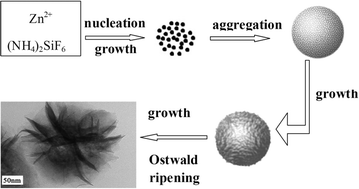3D hierarchical ZnOHF nanostructures: synthesis, characterization and photocatalytic properties†
Abstract
3D hierarchical ZnOHF nanoflowers with mean diameter of 200 nm have been synthesized via a simple template-free hydrothermal route by using (NH4)2SiF6 as the fluoride source. The crystalline phase and morphologies of the as-prepared products have been characterized by XRD, SEM and TEM. The XRD results show that the products are well-crystallized orthorhombic phase of ZnOHF. The SEM and TEM results indicate that the ZnOHF nanoflowers are assembled by numerous nanoflakes with mean thickness of 20 nm. Some factors influencing the morphologies of the ZnOHF nanostructures have been systematically investigated, such as the reaction time, temperature and fluoride source. A growth mechanism is proposed on the basis of a series of time-dependent morphological evolution results. The hierarchical ZnOHF nanoflowers exhibit a high specific surface area up to 97.1919 m2 g−1 with a pore size of 50.098 nm. The as-obtained ZnOHF can be transformed into ZnO nanoflowers by calcination in air at 600 °C. The photocatalytic properties of ZnOHF have been studied by the decomposition of methyl orange (MO) under UV light irradiation. The results indicate that the flower-like ZnO nanostructures are chemically stable, and the efficiency remained almost the same after five times recycling.


 Please wait while we load your content...
Please wait while we load your content...